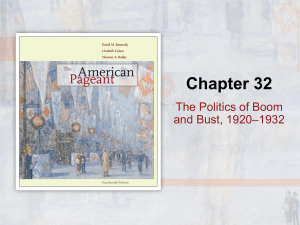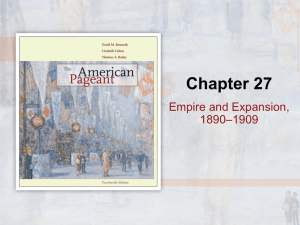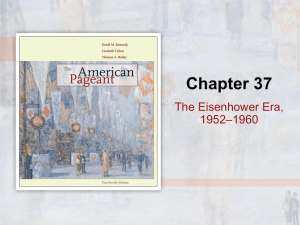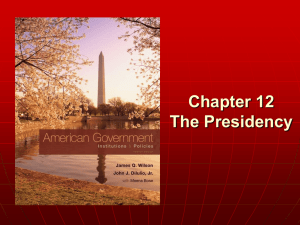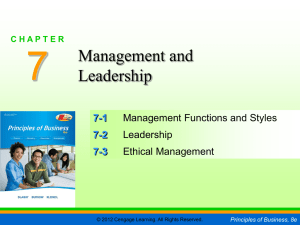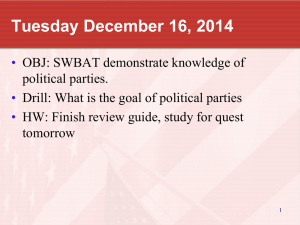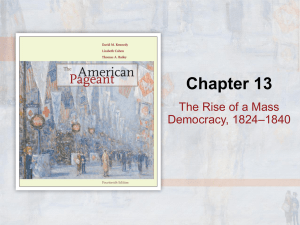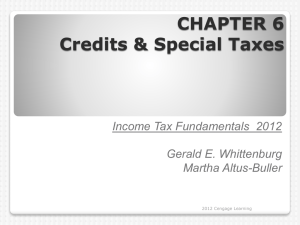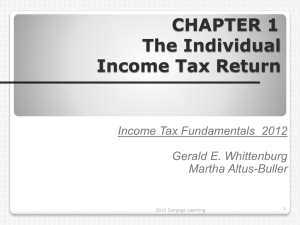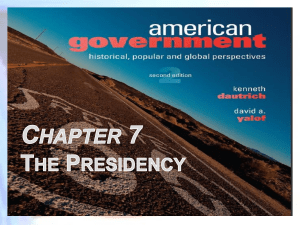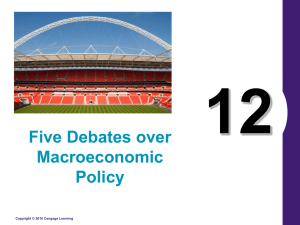chapter 8
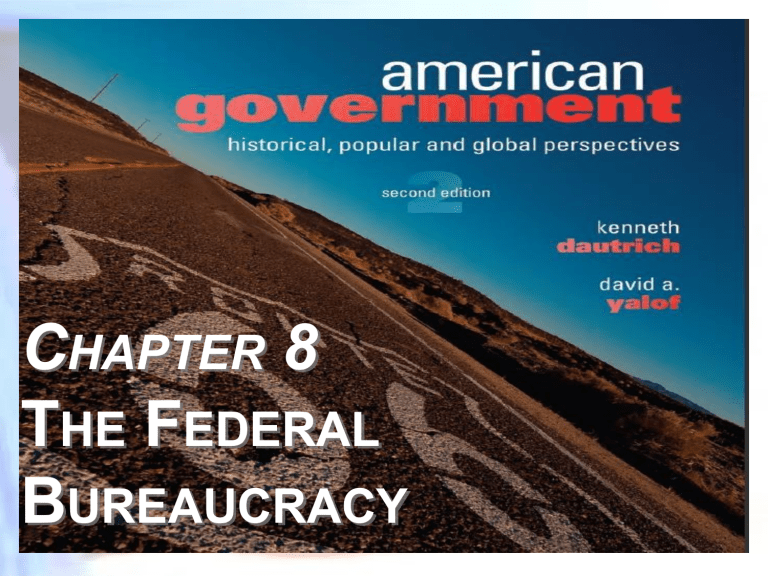
C
HAPTER
8
T
HE
F
EDERAL
B
UREAUCRACY
C HAPTER 8: L EARNING O BJECTIVES
Understand the critical role that the bureaucracy plays in the implementation of federal policy
Identify the bureaucracy as part of the executive branch of government organized hierarchically with standard operating procedures for doing business
Copyright © 2012 Cengage Learning
C HAPTER 8: L EARNING O BJECTIVES
Explain “delegated authority” and describe the conditions under which such authority is granted
Describe the oversight function of
Congress over the bureaucracy
Understand why Congress has provided some bureaucratic units with administrative judicatory authority
Copyright © 2012 Cengage Learning
C HAPTER 8: L EARNING O BJECTIVES
Describe how the federal bureaucracy has evolved over time, including substantial growth spurts as a result of the New Deal and Great Society programs and the Cold War
Copyright © 2012 Cengage Learning
C HAPTER 8: L EARNING O BJECTIVES
Explain methods for attempting to control or reduce the size and scope of the federal bureaucracy through privatization, devolution, deregulation, and accountability
Copyright © 2012 Cengage Learning
C HAPTER 8: L EARNING O BJECTIVES
Define the different types of agencies in the federal bureaucracy including cabinet departments, independent agencies, regulatory agencies, government corporations and the
Executive Office of the President
Appreciate the large scope of the federal workforce and the civil service rules governing federal employment
Copyright © 2012 Cengage Learning
Copyright © 2012 Cengage Learning
……: N
OW & T HEN
Copyright © 2012 Cengage Learning
N OW
…
The “Reagan Revolution” aimed to reduce the burden of government.
Reagan found that he often needed to increase the size of government to accomplish many of his policy objectives.
He left office in 1989 with a much larger bureaucracy than the one he had inherited in 1981.
Copyright © 2012 Cengage Learning
T HEN
…
Thomas Jefferson talked the talk of cutting the bureaucracy, but failed to walk the walk of containing its growth.
In his campaign, Jefferson stressed the need for “frugality” when it came to federal spending.
When he left office in 1809, however, the federal bureaucracy was much larger than the one he had inherited in 1801.
Copyright © 2012 Cengage Learning
W HAT I S B UREAUCRACY ?
Often refers to overgrown government, excessive rules and paperwork, or a burdensome process
Despite negative connotations, it is necessary for any government
Laws must be enforced, programs must be administered, and regulations must be implemented
Copyright © 2012 Cengage Learning
W HAT I S B UREAUCRACY ?
Citizens are more likely to come into direct contact with the bureaucracy than any other part of government
The bureaucracy comes to symbolize what government is
Visit to an unemployment office
Check from the Social Security
Administration
Department of Motor Vehicles
Copyright © 2012 Cengage Learning
People wait in line to speak to a clerk at a
U.S. Social Security office.
Copyright © 2012 Cengage Learning
2.
3.
4.
5.
6.
MAX WEBER’S SIX CHARACTERISTICS OF
EFFECTIVE BUREAUCRACIES
1.
Organized based on specialization, expertise, and division of labor
Hierarchical —chain of command
Standard operating procedures
Good record keeping —paper trail
Air of professionalism
Merit-based hiring and promotions
Copyright © 2012 Cengage Learning
Y OUR P ERSPECTIVE
…
ON A MERICAN
G OVERNMENT
You, Your Parents, and the Dreaded
FAFSA (Free Application for Student
Aid) Form:
What do you think about FAFSA? Is it too cumbersome or tedious?
Is the federal government transforming a simple process into one that is too complex to be effective?
Copyright © 2012 Cengage Learning
Y OUR P ERSPECTIVE
…
ON A MERICAN
G OVERNMENT
Do you believe this form of “red tape” is necessary to ensure that colleges and universities can make fair decisions about financial aid for the nation’s college students?
Copyright © 2012 Cengage Learning
A MERICAN G OVERNMENT . . . IN
P OPULAR P ERSPECTIVE :
MIXED VIEWS ON BUREAUCRACY
Americans exhibited mixed feelings about federal government expansion in response to economic problems during the recessionary period of 2007 –09
Over 8-in-10 either disapproved of government’s expanded role or wanted it to retract once the recession was over
Copyright © 2012 Cengage Learning
W HAT D OES THE F EDERAL
B UREAUCRACY D O ?
Most of the federal bureaucracy is contained within the executive branch
Executive power — to carry out, administer, and enforce specific laws
Primarily a presidential responsibility
The president uses the bureaucracy to exercise executive authority
Copyright © 2012 Cengage Learning
P OLICY I MPLEMENTATION
The process of carrying out a law requires translating the legislation into action
Begin by developing regulations – rules guiding employees in carrying out the program or service
The rules are published in the Federal
Registe r and enforceable by law
Copyright © 2012 Cengage Learning
B UREAUCRATIC L EGISLATION
When laws are vague, agencies have administrative discretion —
Considerable freedom in deciding how to implement the law
Delegated congressional power —
The agency has power to make laws
(administrative law) — power that is supposed to rest with Congress alone
Copyright © 2012 Cengage Learning
C HECK T HE L IST
SENATOR PROXMIRE’S TOP TEN
GOLDEN FLEECE AWARDS
In 1975, U.S. Senator William Proxmire
(D-WI) began taking aim at wasteful pork-barrel spending in the federal bureaucracy
The “Golden Fleece Awards” target bureaucratic agencies spending money on wasteful programs
Copyright © 2012 Cengage Learning
P ROXMIRE
’
S T OP T EN
Copyright © 2012 Cengage Learning
C ONGRESSIONAL OVERSIGHT
Congress’s monitoring of bureaucratic agency performance — accountability
Options : Conduct investigations
Reduce or eliminate the budget
Refuse to confirm appointments
Eliminate the agency, or establish a new agency and shift resources and powers to it
Copyright © 2012 Cengage Learning
B UREAUCRATIC A DJUDICATION
Determining the rights and duties of particular parties within the scope of an agency’s rules or regulations
Most adjudication takes place in the court system
However, Congress has placed judicial power in some bureaucratic agencies
Example: EEOC
Copyright © 2012 Cengage Learning
T HE D EVELOPMENT OF THE F EDERAL
B UREAUCRACY
During Washington’s presidency
Congress created just three departments
Department of State —foreign affairs
Department of Treasury —fiscal affairs
Department of War —military affairs
Later authorized hiring an attorney general and a postmaster general
Approximately 50 federal employees
Copyright © 2012 Cengage Learning
T HE D EVELOPMENT OF THE F EDERAL
B UREAUCRACY
Mid-1800s: Congress created the
Department of the Interior
1862: Department of Agriculture
1870: Department of Justice
1884: Bureau of Labor
1888: Commerce Agency
Early 1900s: Given Cabinet status
Copyright © 2012 Cengage Learning
T HE D EVELOPMENT OF THE F EDERAL
B UREAUCRACY
FDR’s New Deal created a myriad of new federal agencies:
Examples:
Social Security Administration
Securities and Exchange Commission
Civilian Conservation Corps
Copyright © 2012 Cengage Learning
T HE D EVELOPMENT OF THE F EDERAL
B UREAUCRACY
1940 —federal government accounted for 10% of the gross domestic product
1975 —22%
$9.5 billion spent on federal programs
1975 —$332 billion
About 700,000 federal employees
1975 —2.2 million
Copyright © 2012 Cengage Learning
T HE D EVELOPMENT OF THE F EDERAL
B UREAUCRACY
Two factors fueling the massive growth
1.
President Lyndon B. Johnson’s Great
Society program of the 1960s
Social and economic improvements
2.
Cold War —U.S. and the Soviet Union, vying against each other for global influence
Federal budget for defense programs
Copyright © 2012 Cengage Learning
A MERICAN G OVERNMENT . . . IN
G LOBAL P ERSPECTIVE :
ONE ITALIAN WRITER
EXPERIENCES AMERICAN
BUREAUCRACY
In Ciao, America!: An Italian Discovers the U.S., Italian Beppe Severgnini compares his experiences with the
Italian and U.S. bureaucracies
A “matador faced with a milk cow.”
Copyright © 2012 Cengage Learning
G ETTING C ONTROL OF THE G ROWING
B UREAUCRACY
Privatization : replacing governmentprovided services with the private sector
Deregulation : eliminating government oversight and regulation
Devolution : shifting responsibility and power back to the states
“Reinventing Government : ” improved effectiveness and efficiency
Copyright © 2012 Cengage Learning
T HE O RGANIZATION OF THE F EDERAL
B UREAUCRACY
Cabinet Departments
15 major administrative organizations; vary in size and importance
Each is headed by a secretary except
Justice (attorney general)
President nominates; Senate confirms
Copyright © 2012 Cengage Learning
A MERICAN G OVERNMENT . . . IN
H ISTORICAL P ERSPECTIVE :
CONFLICTS WITHIN THE CABINET
1789 –1793 : U.S. Bank —Jefferson vs.
Hamilton
1977 –1979 : U.S. response to the
Iranian hostage crisis —Brzezinski v.
Vance
2003 : militarily intervention in Iraq —
Rumsfeld vs. Powell
Copyright © 2012 Cengage Learning
I NDEPENDENT A GENCIES
Not part of any executive cabinet department, but do report directly to the president
Focus on a narrower scope of issues
Examples : NASA and the Small
Business Administration
Agency heads are appointed by the president and confirmed by the Senate
Copyright © 2012 Cengage Learning
R EGULATORY A GENCIES
Implement rules and regulations regarding individual or corporate conduct related to some aspect of the economy
Not under control of the president
Run by independent boards or commissions that are not supposed to exert partisan influence
Examples : ICC, FTC, FCC, SEC, EPA
Copyright © 2012 Cengage Learning
G OVERNMENT C ORPORATIONS
Run like private companies even though they serve an important public purpose
When revenue falls short, the government will often intervene to keep it in business
Examples : U.S. Postal Service;
AMTRAK; Tennessee Valley Authority
Copyright © 2012 Cengage Learning
T HE E XECUTIVE O FFICE OF THE
P RESIDENT
Managed by the Chief of Staff:
Examples: Communications Office;
Council of Economic Advisors; National
Security Council; Office of Management and Budget; White House Counsel;
Office of Science and Technology;
Office of the U.S. Trade
Representative; etc…
Copyright © 2012 Cengage Learning
T HE F EDERAL W ORKFORCE
Currently 2.7 million civilian personnel, excluding 1 million postal workers, and 1.5 million U.S. military personnel
Political Appointees and Career
Professionals —About 8000 appointees
(usually replaced by a new president)
7500 Senior Executive Service (SES) career professionals (usually remain employed)
Copyright © 2012 Cengage Learning
T HE C IVIL S ERVICE
Majority of the federal workforce
Theoretically hired based on qualifications, and remain employees beyond the term of a president
Historically : the federal workforce began with “higher society” employees
Changed with Andrew Jackson’s “spoils system”—patronage
Copyright © 2012 Cengage Learning
T HE C IVIL S ERVICE
1881 —President Garfield’s assassination strengthened the reform movement in federal employment
Killed by a party worker who didn’t get a job
Pendleton Civil Service Reform Act of 1883
Hatch Act of 1939
Civil Service Reform Act of 1978
Copyright © 2012 Cengage Learning
G ETTING A J OB IN THE F EDERAL
G OVERNMENT
Office of Personnel Management
(OPM): http://www.usajobs.opm.gov
Bruce Maxwell lists four advantages of federal jobs in his Insider’s Guide to
Finding a Job in Washington :
1.
Nation’s largest employer, numerous jobs
2.
3.
4.
Excellent job security
Good wages and benefits
Excellent pension benefits
Copyright © 2012 Cengage Learning
Copyright © 2012 Cengage Learning
Pictured above is the “plum book,” which provides a listing of all job openings in the federal bureaucracy
N OW & T HEN : M AKING THE
C ONNECTION
The federal bureaucracy has grown dramatically since George
Washington’s administration
As new presidents seek to advance new policy goals, federal departments and agencies have been created, modified, and expanded
Copyright © 2012 Cengage Learning
P OLITICS I NTER A CTIVE !
Czars aplenty in the U.S. Government
Special bureaucratic leaders —usually enjoy close, working relationships with the president —no Senate confirmation
Presidents since FDR have made these special “czarist“ appointments
Obama, in his first 15 months in office set a record number at 38
Copyright © 2012 Cengage Learning
P OLITICS I NTER A CTIVE !
Do you think that all high level appointments made by the president should require congressional confirmation before they can serve?
Should the so-called czars be formally confirmed by the Senate just as are all cabinet-level and many sub-cabinetlevel appointments?
Copyright © 2012 Cengage Learning
P OLITICS I NTER A CTIVE !
What accounts for the increased use of czars by Presidents George W. Bush and Barack Obama?
Has the growth and increased complexity of the federal bureaucracy created an atmosphere wherein presidents need a special advisor to coordinate agencies in a specific problem area?
Copyright © 2012 Cengage Learning
Copyright © 2012 Cengage Learning
Carol Browner, Assistant to the President for Energy and Climate
